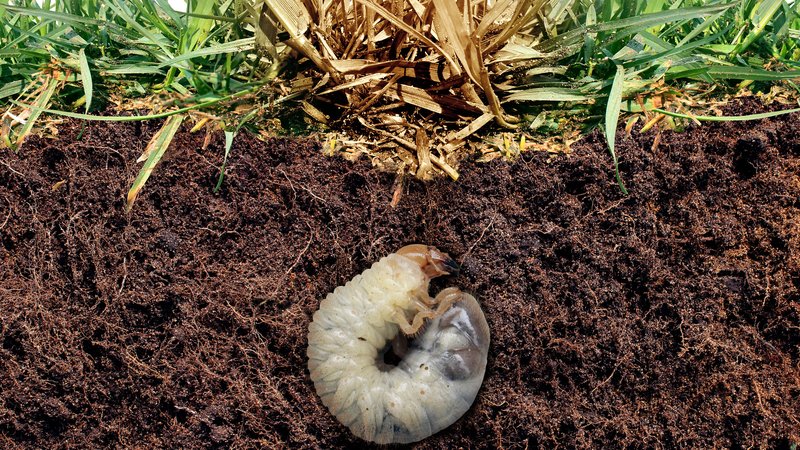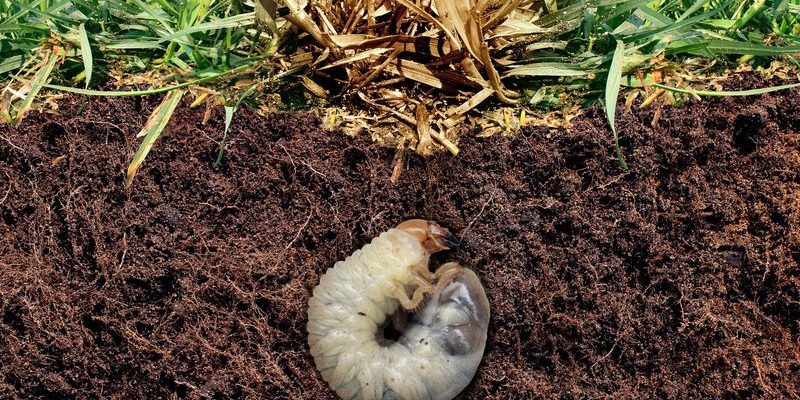
Grub worms aren’t actually worms; they’re the larval stage of several types of beetles, such as June beetles and Japanese beetles. Think of them as the baby versions of these insects, feeding underground before they make their grand entrance into the world. They’re typically white or cream-colored with a C-shape and can grow up to an inch in length. When you spot them in your garden, it’s like finding the little culprits behind a mess you’ve been trying to clean up.
As we unravel the mystery of these lawn invaders, you might be wondering why they’re a big deal. Well, besides having an unsightly lawn, grubs can cause serious damage to your yard’s roots, which may lead to dead patches or even attract other pests like raccoons or skunks that dig up your lawn in search of a meal. So, understanding grub worms is the first step to keeping your lawn healthy and green.
What Do Grub Worms Look Like?
When it comes to identifying grub worms, it’s helpful to know their distinct features. These larvae are mostly white or light brown in color, with a soft, elongated body that curls into a C-shape. They have a small head that can be a darker shade and three pairs of legs.
If you’re unsure whether you’ve spotted a grub worm, here are a few identifiers to keep in mind:
- Size: Typically about 0.5 to 1 inch long.
- Color: White or cream with lighter or darker head.
- Shape: C-shaped body.
- Location: Found just beneath the soil surface, particularly in areas with dying grass.
Distinguishing them from other pests can be tricky, but if your grass is wilting or has brown patches, there’s a good chance grubs are the culprits. These little guys thrive in moist, rich soil—perfect for the roots of your favorite lawn plants.
Life Cycle of Grub Worms
Grub worms undergo a fascinating transformation, which is essential to know if you’re looking to manage their impact. Their life cycle consists of four main stages: egg, larva (the grub stage), pupa, and adult beetle.
1. **Egg Stage**: Adult beetles lay their eggs in the summer, usually in moist soil.
2. **Larva Stage**: After a few weeks, the eggs hatch into larvae, feeding on grassroots. This is when they are most damaging.
3. **Pupa Stage**: As they grow, they enter the pupal stage, where they transform into adult beetles.
4. **Adult Stage**: In late spring to early summer, the adult beetles emerge, ready to lay eggs and start the cycle anew.
Understanding this cycle is crucial for timing your treatments effectively. For instance, you may want to target them at different stages to minimize damage to your lawn.
Why Are Grub Worms Bad for Your Lawn?
You might be asking yourself, “What’s the big deal about a few bugs?” Well, grub worms can cause significant damage to your lawn. As these tiny herbivores munch on your grass roots, they weaken the plants, often resulting in brown patches and a thinning lawn.
Here’s why grubs are particularly troublesome:
– **Root Damage**: They feed on the roots, which can ultimately kill patches of grass.
– **Attracting Other Pests**: Yard invaders like raccoons, skunks, or birds may dig up your lawn in search of grubs, leading to additional harm.
– **Long-term Effects**: The damage caused by grubs can lead to a more prominent decline in the lawn’s health over time, requiring more effort and resources to restore.
Preventing grub infestations is much easier than dealing with their aftermath. So, keeping an eye on them can save you a lot of hassle.
Signs You Have a Grub Problem
Detecting grub worms early can save you from extensive damage. Here are a few signs that might indicate you need to take action:
– **Brown Patches**: Areas of your lawn may start to lose color, causing unsightly brown spots.
– **Easily Uprooted Grass**: If your grass can be pulled up easily, it’s a sign that the roots are being eaten away.
– **Presence of Predators**: If you notice creatures like birds or raccoons digging in your yard, they might be on the hunt for grubs.
If you suspect a grub problem, it’s time to roll up your sleeves and investigate further. Gently pull back sections of grass to see if any grubs are lurking just beneath the soil.
How to Manage Grub Worms
Dealing with grub worms doesn’t have to be a nightmare. Here are some effective strategies to keep them under control and restore health to your lawn:
1. **Natural Predators**: Introducing natural predators like nematodes can help reduce grub populations. These microscopic worms invade the grubs and effectively kill them.
2. **Chemical Treatments**: If you opt for a chemical solution, look for insecticides specifically designed for grubs. Make sure to follow the instructions carefully for the best results.
3. **Cultural Practices**: Maintaining a healthy lawn through proper watering, fertilizing, and mowing can help it withstand grub damage better.
Timing is essential—treatments are usually best applied in late summer or early fall when grubs are still active. This is when they’re eating the most and are easier to target.
Preventing Grub Infestations
Prevention is the best policy when it comes to grub worms. Here are some tips to keep these pesky invaders at bay:
– **Regular Lawn Maintenance**: Aerate your soil and keep it healthy to discourage grubs from settling in.
– **Proper Watering**: Overwatering can invite grubs, so aim for a balanced watering schedule that keeps your lawn hydrated but not soggy.
– **Healthy Soil**: Adding organic matter can improve soil health and deter grubs from taking hold.
Have you thought about using a lawn care program? Many programs include grub control as part of their routine treatments, helping you manage these pests more easily.
Grub worms may be small, but they can cause significant damage to your lawn if not managed properly. By understanding what they are, how they live, and the signs of their presence, you can take proactive steps to protect your lawn. Prevention and early detection are crucial, so keep an eye on your grass health and consider using cultural practices or treatments to keep these lawn invaders at bay.
With the right knowledge and a bit of effort, you can maintain a vibrant, healthy lawn that makes your yard the envy of the neighborhood—without the pesky grub worms crashing the party.

